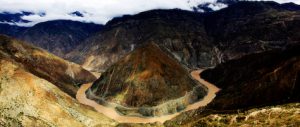“Hydropower development is a must,” said a senior official from China’s top economic planners, the National Development and Reform Commission (NDRC), effectively breaking seven years of silence on hydropower exploitation on the Nu River – China’s last great waterway without large-scale dams – and dashing the hopes of campaigners who successfully halted development in 2004, after a public outcry.
Feeling the pressure from energy-efficiency and emissions-reduction targets in China’s 12th Five-Year Plan, due to be published next month, the government and state-owned electricity enterprises are ramping up their hydropower ambitions. Bets are rising on a “Great Leap” in hydropower exploitation.
On January 28, Shi Lishan, deputy head of the New Energy and Renewable Energy Division of China’s National Energy Administration, set out his views on the Nu River (also known as the Salween): “My belief is that development is a must. Because the Nu’s upper and lower reaches are already built up, in the past some people have said that it is necessary to leave a stretch of free-flowing river. I believe that putting that theory into practice is not realistic.
"We expect that, on the basis of strong evidence, and after seeking the opinions of all parties, that we can press ahead with hydropower construction on the Nu River.”
A journalist who has long reported on hydropower issues in China is Liu Jianqiang, chinadialogue’s Beijing editor. He believes that hydropower development has caused so much controversy in the past in China because of the negative impact on ecology and displaced people – but that now hydro interest groups are using the need for energy and emissions saving as an excuse to promote a new round of frenzied hydropower development.
In 2004, under pressure from environmental groups and the media, the prime minister, Wen Jiabao wrote in the State Reform and Development Commission report on the Nu River hydropower development project that “given the high level of social and environmental concerns over the large scale hydro project, further careful research is required in order to reach a scientific decision”.
In the years following this event, the hydropower developers on the Nu kept a low profile, studiously avoiding doing anything to draw public attention. But the high-sounding sentiments from authorities in recent weeks have led Chinese NGOs to believe this time, the problem is serious.
The Nu is one of south-west China’s great rivers, starting high up on the Qinghai-Tibetan plateau and flowing down to the Indian Ocean. Its water resources are rich and it is currently China’s only large river without any large-scale dams.
According to the first plan for dam construction on the Nu, a string of 13 hydropower stations would produce annual output of 102.96 billion kilowatt hours. When completed, the value of the electricity generated could reach 36 billion yuan. Every year, it would generate 8 billion yuan in tax revenue for the government and local government coffers would also grow by 2.7 billion yuan.
“It’s true that hydropower exploitation can bring economic development, but not necessarily to the benefit of local people,” says Ma Jun, director of Chinese NGO the Institute of Public and Environmental Affairs (IPE). He believes that today’s insufficiently transparent policymaking mechanisms are maximising the interests of hydropower industry, officials and a small number of experts, while driving ecological destruction, affecting local livelihoods and increasing the risk of geological disasters.
Back in 2003 and 2004, proposals to build a string of dams on the Nu River provoked a fierce debate. A journalist from China Economic Times reported seeing a report on a meeting to assess hydropower projects on the middle and lower Nu, which said: “Hydropower development on Nu river is unstoppable. Preparatory work of next stage will be carried out as soon as the state approves.”
Today’s “hydropower is a must” has something of the flavour of that report’s “unstoppable”. But, back then, central government ultimately backed the voice of the people. Today’s government is more worried about how “clean” hydropower energy can help the government fulfil its low-carbon promises.
The Chinese government has committed, by 2020, to getting 15% of its power from renewable sources. By 2020, it is also bound to reduce the carbon-intensity of its emissions by 40% to 45%, based on 2005 levels. However, to hit the energy-saving and emissions-cutting targets in the 11th Five Year Plan period, electricity supplies were cut off in some places. And, in the first half of 2010, energy consumption per unit of GDP jumped, showing just how difficult it will be for China to achieve the energy targets.
At the end of 2010, Zhang Boting, vice secretary of the China Society for Hydropower Engineering, told reporters that the 12th Five Year Plan called for hydropower development to be prioritised. For various reasons, two thirds of the hydropower projects detailed in the 11th Five Year Plan had not been completed and would be revived in the 12th Five Year Plan.
In November last year, the waters of the Yarlung Zangbo (which becomes the Brahmaputra downstream) were dammed for the first time as part of a project to build Tibet’s first large-scale hydropower station, at Zangmu. Immediately afterwards, the developers commenced the plant’s main construction stage. Geologist Yang Yong told Southern Weekend that this event marked the “start of a hydropower age in Tibet”. Four of China’s “big five” electricity companies have already made their way into the region.
It is not only the future of the Nu River that is at stake. In January 2011, in order to boost hydropower construction, a proposal was submitted to shrink a reserve for rare fish on the upper reaches of the Yangtze River, threatening the existence of many species. At the end of 2010, China’s oldest environmental NGO, Friends of Nature, requested a public meeting with the environmental authorities, but their request was denied.
In the past, the Ludila, Jinanqiao, Long Kaikou and other hydropower projects were stalled due to obstruction by environmental groups and the pressure of public opinion. But now, one by one, the embargo on these projects has been lifted.
Ma Jun says: “Environmental groups are not completely against dams. We approve of appropriate development. But China’s present speed of development is excessive.” He says that, by 2004, China had overtaken the US to become the country with the world’s largest hydropower capacity. At that time, the target was to reach a capacity of 300GW, equivalent of tripling capacity within 16 years. After another 15 years, China’s hydropower resources will reach their limit. “Now there is no way to undo the destruction and this will becomes a historic regret,” he says.
Ma Jun says that if hydropower exploitation on Nu River gets going again, it will very likely trigger a new wave of high energy-consuming industrial development in south-west China, due to local government plans to use the newly generated electricity to exploit the area’s rich mineral resource. This is difficult to square with the national goal of low-carbon development.
Ma Jun’s research shows that in many areas of Yunnan province, to adjust the unstable electricity generated from hydropower, coal-fired power plants of the same scale are built up as back up. The Nu River could face the same situation, given its unstable water flow in different seasons. And this is difficult to square with national goals on low-carbon development.
The National People’s Congress (NPC) and Chinese People’s Political Consultative Conference (CPPCC) – two top government bodies – will meet in March this year. And the elements of the 12th Five Year Plan concerning energy efficiency, emission reduction and hydropower exploitation will be at the heart of their discussions. At the same time, Friends of Nature has been calling on local green groups to write open letters to NPC and CPPCC representatives, urging them to reconsider plans to shrink the national-level nature reserves on the upper Yangtze River.
Meng Si is managing editor in chinadialogue’s Beijing office.
This post was originally published as part of The Guardian‘s Green Blog Festival.
Homepage image from SunnyBada


